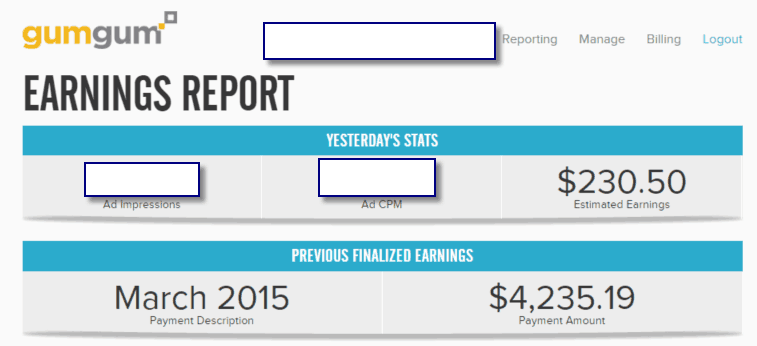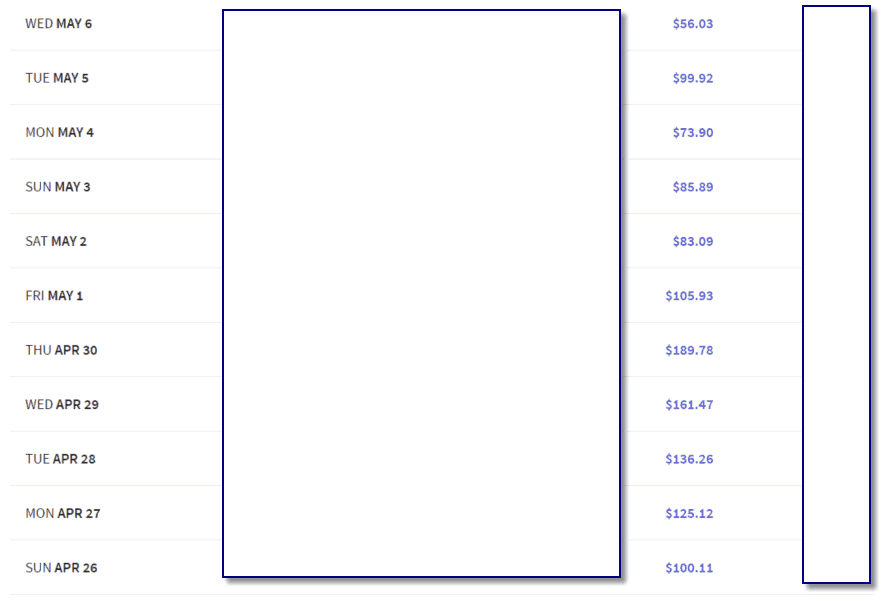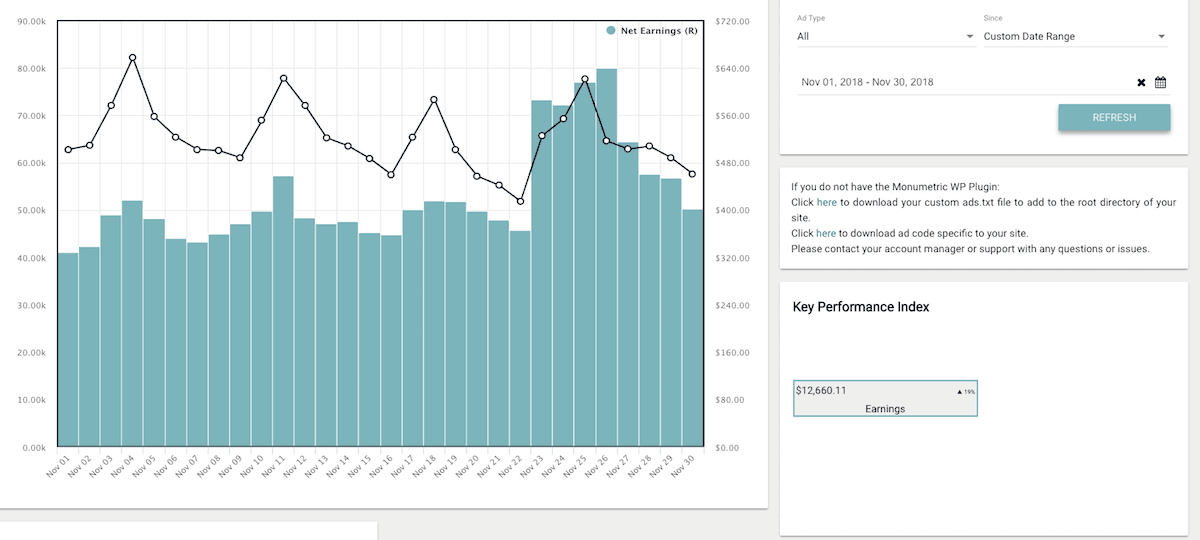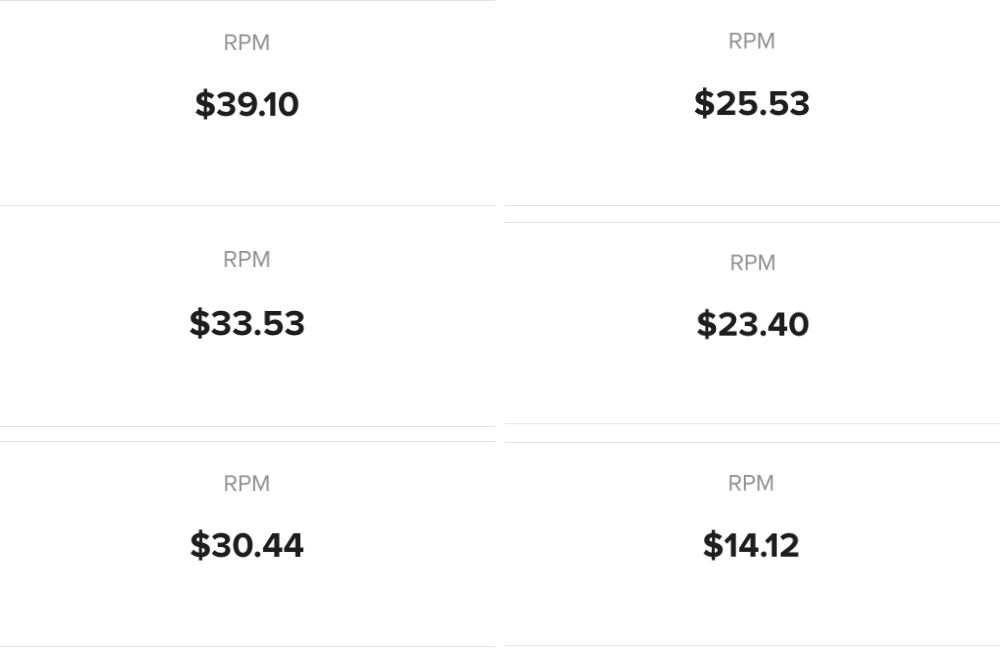
UPDATED December 7, 2018
This post is based on extensive personal testing and use of many ad networks on my largest B2C niche site which currently receives over 2.5 million monthly page views.
With this level of traffic, I’m able to quickly test ad networks and determine whether they’re worth using.
Below is my list of 18 top Adsense alternatives or ad networks for additional incremental revenue.
IMPORTANT: I still use AdSense. However, I’ve used many ad networks over the years. I use multiple ad networks currently. This article sets out all I know about ad networks I’ve used and am using. I include some that I’ve never used but have heard about them from publisher colleagues.
This isn’t some regurgitated list of ad networks which you can easily find by searching Google yourself.
This list is based on a wide variety of ad networks I’ve tried. Some I continue using while others not any more, but I include them because they may be good for your to try.
Most importantly, the set of ad networks and options below are a diverse set of advertising options.
17 Best Ad Network Options Other than Adsense
The list goes to 19, but 2 on this list are no longer available. I kept them on the list just for your info.
1. Ezoic
Ezoic is a different ad network concept altogether. I’ve worked with them for quite a while. Read more about Ezoic here (my very recent and upated Ezoic review).
I’m not currently using Ezoic, however, if you want to do some split testing, it’s a good platform to try.
Ezoic is a certified Adsense publisher. Ezoic in a nutshell manages and optimizes your ad placement. Their software for testing ad placement is amazing.
They provide Ad Exchange ads which you can set up to split test with your AdSense. The split testing features are amazing. Moreover, via Ezoic you can have 5 ad units on your site instead of the usual 3 permitted by AdSense.
Currently, I’m using Ezoic for mobile (AMP). It takes several weeks for Ezoic to conduct testing. In fact, testing never ends, but the first several weeks is when the system really tests a lot of ad placements and layouts. As it does this testing, it rules out poorly performing layouts.
You can optimize your site for revenue, bounce rate and/or page views. I choose to focus on revenue.
You do need an AdSense account in good standing in order to work with Ezoic. If they accept your site into their system, I suggest embracing the opportunity. Just be patient during the first few weeks because the revenue won’t be great as the system starts its testing… but it doesn’t take long for revenue to climb.
Generally, Ezoic states its system can significantly increase a site’s ad revenue through extensive testing, sometimes up to 200%+. While I didn’t enjoy a 200% revenue increase, the revenue they can generate along with the split testing can help. Moreover, I like the fact that they are a very knowledgeable sounding board for ad placement ideas.
If you use display ads on your site, I suggest giving Ezoic a shot. However, don’t pull the plug on day 3. You need to commit to letting the initial extensive testing run its course.
New Ezoic Info (November 2016): Ezoic is launching an AMP (accelerated mobile pages) app that will turn your mobile display into AMP for Google search engine visitors. This is very exciting. Ezoic is in the process of setting me up with this. Moreover, Ezoic will monetize the AMP pages, which isn’t so easy to do since you must create AMP specific ads in AdSense. I will cover this in more detail once it’s up and running on my site (any day now).
2. Monumetric (Formerly The Blogger Network)
Updated info: Monumetric is now my highest earning advertising network. I’ve been working with them for most of 2016. This is still the case in 2018. I earn more with Monumetric than with AdSense. Read my Monumetric review here.
Monumetric uses header bidding which has improved performance. Of course they aren’t the only outfit that offers header bidding.
They are very progressive in new ad concepts. For example, they provide desktop/mobile sticky ad units which earn ridiculously well. This ad network is a serious alternative to AdSense.
In the beginning I rolled them out slowly. It didn’t take long to realize this ad network means business. The revenue they generate for me is excellent. I still don’t fully understand how they do it, but they have some excellent advertisers in their network (in addition to Ad Exchange).
Monumetric pays on a per page view basis instead of a per click basis. This is great, especially since their CPM is reasonably good.
Here’s a recent earnings chart from Monumetric for my bigger site. While it’s not a fortune in revenue, keep in mind this is purely incremental revenue from sidebar and footer ad placements.
3. Media.net
I’m not currently using Media.net but I have extensively. I’m not using them because my placements are maxed out with a few AdSense ads and then mostly Monumetric which has worked great for me.
However, I think most smaller publishers should try Media.net. Even bigger publishers. The ads can pay well. This is especially the case if you don’t have an AdSense account.
They offer terrific ad customization resulting in high ad conversion and the RPM is decent. The ads are link units that look fabulous and come in many designs. Often they look like menu navigation with text links. These units can get an excellent click through rates in many niches (not all niches, but many). It’s a contextual ad network in that the keywords in the ads are based on the sites’ content.
You can place up to 3 ad units on a page.
Overall, Media.net is a little more lenient about placement than AdSense… although they do have a terms of service you must be familiar with. Like Adsense, Media.net (and all quality ad networks) will not tolerate garbage traffic and click fraud.
Since starting with Media.net, I’ve consistently increased my revenue with them. Here’s a recent earning screenshot (just to show you can actually earn decent revenue with their ad network.
Just as you need AdSense approval with AdSense, you must also apply and be approved with Media.net.
Media.net updates:
In November 2016 they’re rolling out in-image ads. I’m in their beta program to see how they perform. This could be an exciting additional offering.
In 2018 they rolled out video ads.
4. My favorite video ad platform
I use one video ad on my 3 biggest sites and combined they generate $3,500 to $5,500 per month with CPMs ranging from $8 to $10. I’ve tried many video ad networks and the one I use is by far the best.
Why is it so good?
- It’s silent by default.
- There’s a sticky feature so that you can have float in the bottom right. The longer the display, the more your earn. This is a very powerful feature.
- It includes video content relevant to my niches. In other words, it’s not all ads. It actually includes some cool content that gets visitors attention.
- It does not slow down my site.
- It pays extraordinarily well. No ad unit I’ve ever used generated such a high CPM.
Which video ad network is it?
5. Criteo
Update: Criteo is no longer available for publishers.
6. GumGum
Specifically, I used GumGum image overlay ads. These are ads that display banners at the bottom of images. I often consider putting their ads on my sites again, but I’m pretty maxed out right now and fear it would be overkill.
My B2C niche sites are image-rich, so GumGum is a perfect ad network to add to the site.
You can choose how aggressive the ads display such as 10% of images, 20% of images and so on. I go with 12% to 15%. I don’t want every image to have an ad on them.
The one issue with GumGum is you need to have a minimum of 500,000 monthly page views in order to have an account. If you get this traffic volume and have images on your site, I recommend you give them a shot.

7. Amazon CPM
Amazon ended their CPM display ad program.
8. Spoutable
UPDATE 2018: I’m using Spoutable’s exit intent ad on 2 niche sites. It’s a nice chunk of incremental income.
Spoutable is a new ad network and it’s a very smart concept. Essentially, Spoutable uses exit intent technology. When a visitor indicates they are leaving the site by placing cursor on the browser address bar, the Spoutable ads pop up.
Spoutable ads are in the same format as native ads. Basically they promote other content much like Taboola and Outbrain ads. This is good because the ads are promoting other interesting content… not hard-selling something.
The engagement is quite high. I think the ads look great.
Currently, Spoutable is on an invite-only basis, but you can apply here.
Here are some recent earnings I’ve had with Spoutable. Revenue fluctuates somewhat, but that’s common with many ad networks.

Note: Currently I’m testing Spoutable by turning them on and off to see if they cannibalize other ad networks. I don’t think they are, but I always do this testing with new ad networks. Overall, the revenue is decent. If you get an invite to use them, I suggest you test them as well.
9. EngageBDR
EngageBDR invited me to place some of their ads on my site. They offered a very high RPM so I gave it a shot.
The revenue these ads generated was awesome and it was based on a CPM basis. That said, I know their ads generated a lot of clicks… and if those clicks didn’t happen on my site, EngageBDR would have ended their relationship with me.
However, I’m no longer running EngageBDR ads on my site because their ads were slowing my site down. They were gif format. They tried to fix the issue, but it wasn’t fixed. I had readers complained about site performance, so I removed the ads. I didn’t like removing the ads because they made a lot of money, but I can’t sacrifice user experience for the sake of revenue to the degree these ads did.
I’m including EngageBDR in this list because I think you should give them a shot if you can get into their ad network. Perhaps you won’t have the same site issues I did. If you don’t, you can make a lot of money with them… in fact if your site performs well for them (i.e. you generate a lot of converting traffic for them), these ads could exceed Adsense revenue on an RPM basis.
I ran EngageBDR ads for a short time (March 12 to March 31) – here’s what they earned:

10. Taboola
Taboola ads are native advertising ads. These ads link to popular and enticing content. You’ve likely seen them on other websites… they’re the ads that follow “From the Web” or some similar phrase.
Taboola is an ad network I don’t use much. It’s one I haven’t had a great deal of success with. However, I’m including Taboola because I have publisher colleagues who generate a great deal of revenue with them.
For some reason Taboola ads don’t work all that great in my niche. But they do perform well in many niches, so I suggest you give them a shot. These ads have a relatively high CTR and with a lot of traffic, can generate some great revenue.
Typically these ads are placed in sidebars and below content. You should also definitely test some in-content placement as well.
FYI, Taboola isn’t the only native ad network. There are many of them. Too many to list. Outbrain is another popular native ad network, but you need millions of monthly page views in order to place Outbrain’s ads on your site. Taboola doesn’t have such a high threshold.
11. Vibrant Media
I used Vibrant Media’s in-text ads for several months. I earned $7 to $10 per day. It wasn’t much. I don’t use them any more; however, I’m including them in this list because I think they’re worth trying.
The reason they didn’t do well for me is because my B2C sites are image-rich. The text is much less important. Since Vibrant Media’s in-text offering is focused on in-text links, I’m not surprised they didn’t do well for me.
If your site is rich with text-based information and you get 500,000 monthly page views, I suggest testing Vibrant Media.
=> Click here for Vibrant Media
12. RevContent
RevContent is in my view the most progressive native ad network. They have some amazing ad options, especially for mobile.
I tested them quite a bit. I love them, but unfortunately they weren’t a great fit for my niche.
That said, I think every site that uses ads to monetize should try RevContent because if it is a good fit, they can make you a ton of money. I’ve seen revenue from colleagues and it’s very, very high. The revenue CPC can be excellent in certain niches.
13. PowerInbox
I’m currently using PowerInbox to monetize my email newsletters. If you can’t seem to generate much or any revenue with your email newsletter but have a good number of subscribers, give PowerInbox ads a shot.
PowerInbox provides native ads that you can insert into your email newsletter. They’re fairly engaging and their algorithm adjusts over time so that it serves ads your readership responds to.
The ad units are horizontal and vertical units (called stripes). You can place one, two or more stripes in your newsletter.
I’m getting $7 to $14 RPM from these units which I’m happy about.
14. Skimlinks
I’ve known about Skimlinks for years.
Update 2018: I use Skimlinks on all sites now and love it. It makes adding affiliate links so much easier and faster. I wrote a full-blown Slimlinks review here.
Skimlinks is a monetization platform that turns all links to merchants in their network into affiliate links. For example, if you place a link to Amazon.com, Skimlinks will turn that into an affiliate link.
3 Main reasons I use Skimlinks:
Skimlinks is an affiliate marketing tool turning links into affiliate links sitewide.
You might be thinking, why would I choose to pay a middle person a part of commissions when I can insert affiliate links directly on my site and earn more. It’s a good question. There are 3 main reasons I use Skimlinks:
- Convenience and Efficiency: I have writers produce most of my content. They place links to various merchants. By using Skimlinks, I don’t have to go back into that content and place my affiliate links. Moreover, I don’t have to apply to dozens or hundreds of merchants because Skimlinks has relationships with something like 20,000 plus merchants.
- Higher commission rates: Skimlinks has negotiated higher commission rates with some merchants so even though Skimlinks skims some money off the top, the net commissions to me can be higher.
- Reporting: While Skimlinks reporting could be improved, the reporting is super convenient and I can see which web pages on my site generates the most affiliate commissions across all merchants very quickly.
The main reason I use Skimlinks is with so many writers on my sites creating links to merchants, it saves me a ton of time because I don’t have to go back and insert affiliate links.
Am I making more money with Skimlinks?
No, but I’m not making less. My affiliate commissions have always fluctuated, but overall my affiliate revenue remains about the same. Therefore, I love the convenience of using Skimlinks.
Also, I do not set Skimlinks to override existing affiliate links. I only have Skimlinks turn non-affiliate links into affiliate links.
15. Amazon Native Ads
Amazon native ads are a performance-based advertising program. Basically Amazon provides you code which generates attractive product grids you can place anywhere on your site. If your site content revolves around topics for which there are physical products available, these units can perform very well.
In order for you to earn revenue, a site visitor must click a link or image in the ad and then purchase something at Amazon from which you earn a commission.
These units are available and can be created in your Amazon Associates portal.
16. Infolinks
I recently gave Infolinks a try. I love their platform. I like some of their ad offerings, but I’m very happy with my current ad mix and since my sites are image-centric, the text link ads didn’t really do well. I do think, however, if your site has plenty of text that Infolinks is worth trying.
Infolinks is popular ad network. Their claim to fame is turning text into link ads on your site. They aren’t affiliate links like Skimlinks; instead, the ads pay per click.
Since then, Infolinks has expanded its ad offerings to include the following:
- Intext: These are the ads that put them on the map. Basically Infolinks turns keywords on your page into hyperlinks. When a visitor hovers the cursor or finger over the link, an ad pops up.
- Infold: These are pretty obtrusive, but can earn well. It’s a large ad that appears from the bottom of your site.
- Inframe: These are gutter ads.
- Inscreen: These are pop up ads.
- Inarticle: These are link units you can put pretty much anywhere on our site.
I’m considering running their inframe ads again. I don’t have these types on my site and so it’s a unique offering that may add some nice incremental revenue.
17. Mediavine
I believe you need an active AdSense account to use Mediavine. You also need 35,000 monthly page views. While I don’t use Mediavine, I’ve talked to many publishers who do and have had outstanding results.
Based on what I’ve heard, they are a definite must-try.
Why don’t I use them? They denied me. I still can’t figure it out. I’ve never been denied an ad network except for Mediavine and AdThrive. Go figure.
18. AdThrive
Like Mediavine, I’ve heard from publishers that AdThrive gets amazing results. I’d like to try them but my application was rejected. I was given no reason either.
If you can get in, it’s worth trying. They handel all ad optimization which saves you time. I know I’d save time from my tinkering.
19. Nativo
Nativo is a new addition to my site. Revenue has been okay. The concept is unique. The ad they put on your site links to an article they provide. The article is also on your site (they load the article and ad from their end).
Nativo told me they prefer sites within a niche rather than general websites.
20. Underdog Media
Underdog Media has some great display ad options such as gutter ads, slide-in ads and sticky ads. I see their ads on a lot of sites. They’re a pretty big player. I ran them for a while, but prefer Monumetric’s sticky ads.
I like Underdog’s gutter ads, but like in-image ads, it’s just too much at this point for my site.
One Other Ad Network to Try (if you can get approved)
If you can get approved, try exponential (formerly called Tribal Fusion). I think that is would be a very good alternative to AdSense.
I applied to exponential (when it was called Tribal Fusion) and was denied. This was about 2 years ago, so maybe I’d be approved now… I don’t know. They talk a big talk and it seems they do perform well. However, they are very, very difficult to be approved for. They have a 500,000 monthly page view threshold, strict website quality requirements and they require that you place their ads above-the-fold.
If you can be approved, I think you definitely want to try Tribal Fusion. One day maybe I’ll be approved for one of my sites.
If you’ve been banned by AdSense, you definitely want to see if you can get into exponential.
Comments About Using Multiple Ad Networks
One of Ezoic’s recent updates is that they now permit you to run ad networks in addition to Ezoic. When I first used Ezoic I could not use additional networks that participated on Ad Exchange (such as Media.net). That was a huge problem for me because Media.net has always been such a great revenue source.
However, in 2015 Ezoic completely revamped their platform and now permit me to use Media.net and other ad networks in addition to Ezoic.
It’s a balancing act when adding more ads to any web page. You want to avoid cannibalization of your higher earning ads.
This why it’s good to test new ad networks one-by-one to determine how additional ad networks impact overall revenue.
The reason the above mix of ads works well as an Adsense alternative or in addition to Adsense ads is they offer unique features and operate differently. For example, GumGum enables you to monetize images.
Media.net ads perform very well in content and below content because the ads look like navigation options. Amazon CPM ads work great because you can place them anywhere and earn on a strict CPM basis.
More is not necessary more. Less is not necessary more. It takes testing. Every site is unique. What works well for me may not work well for you. Nevertheless, the above list is a set of proven ad networks that you can test.
Even if you discover only one additional ad network that works well for you, the 6 minutes it took to read this list was time well spent.
Adsense Compliance
As far as I know, all of the above ad networks are fine to use with Adsense on a web page. Please note that I am not a Google Adsense employee and so I don’t know for sure… however, I’ve no issue incorporating the above ads on my site with Adsense. I just ensure the ads aren’t placed next to Adsense and I ensure the ads do not appear in a similar style to Adsense ads.
How to choose the right ad network(s) for you
If you still have an AdSense account, you’ll probably include AdSense units on your site because it undeniably will earn money very well relative to other networks… but I suggest testing additional ad networks. Even though AdSense lifted the ad unit cap, it’s not a free-for-all … in fact I recently learned how many AdSense units was too many on one of my niche sites.
If you don’t have an AdSense account anymore or are waiting for AdSense approval, don’t sweat it. There are many other great networks and ad varieties you can use to generate revenue.
I’ve tested and used many ad networks over the years. I get proposals every week to use a new ad network. Here are some tips on choosing the best networks for your site(s):
Be judicious:
It takes time to add code and test new ads. Therefore, don’t feel you have to jump and work with every ad network that contacts you. Check out their units and ask yourself: “will these ads look good on my site and could they do well?”
You’ll also want to ask what are some of the higher CPM rates other publishers with them earn. I ask this immediately. If they reply $2 or less, I’m not interested. If they say $5 or more, we’ll talk. I’ll then inquire which types of ads are generating such CPMs. If the ads are insanely annoying, I’ll decline.
Test slowly
When I test a new ad network, I don’t just stick the unit in the best spots. I put the units below the fold and see how they do there. I realize they won’t earn a ton there, but if they do well there relative to other networks, I’ll keep working with them.
Minimum Payout
I NEVER choose an ad network based on minimum payout. That’s kind of lame feature to promote. Don’t get suckered by the lowest a low payout threshold. What you want is to look for ad networks that will pay well per 1,000 visitors.
FYI, a payment threshold is how much you must earn before you’re eligible to receive payment.
Are the ads unique?
I like unique offerings. In fact, I like ad diversity on my site. That’s a big reason I work with multiple ad networks.
These days you can put ads anywhere at almost any time. When choosing ad networks, think about what each offers for your site and where they’ll go. That said, you don’t want so many ads on your site that visitors can’t read/view/watch your content. It’s a balancing act.
Here’s a list of the main types of ads (a website advertising glossary) available for a website.
- RPM: Revenue per 1,000 page views.
- EPMV: Ezoic’s preferred ad revenue tracking metric. It stands for “earnings per 1,000 visitors”.
- CPC: Cost per click. It means you earn money when an ad is clicked.
- CPM: Cost per 1,000 ad impressions. Some ads pay per impression.
- CPA: Cost per action: You earn revenue only after an action is taken subsequent to the ad click. Example is someone fills in a form or buys something.
- Contextual ads: Ads which are based on the website content.
- Link Units: Text link ads. Usually a list of keywords linked to a landing page. You usually don’t earn until a link on the second landing page is clicked. I wrote about Link Units in detail here. Ad Networks that offer these are AdSense and Media.net.
- Pop-under ad: These units are large ads that show up when you close a website/window.
- Pop-up ad: These are units that pop up on top of a website. The trigger can be time-on-site, percent down the page or clicking something.
- Text ads: These are text-based ads. Many networks offer these. They’re standard fair.
- Image/rich media banner ads
- Interstitial: These are full page ads that appear arriving to a site and/or when clicking to another page on the site. They’re very intrusive, but can earn a lot of money.
- Native: These are ads that promote regular content. They’re classic clickbait and go to long-form content pages.
- In-text advertising: These are ads created from words in the text. An example is the Infolinks network.
- Performance-based Advertising: These are ads that pay based on some performance threshold, usually affiliate links that pay a percent of the ensuing sale of something.
- Mobile Ad: More and more ad networks focus on mobile ads. Ads are smaller for mobile and may behave differently. There really aren’t a lot of placement options for mobile ads yet ad networks continually scramble to come up with a big mobile earner.
- Gutter ads: These are ads that are placed on the left and/or right of a website in the gutter space. They can be sticky, which means they float down the page as a visitor scrolls down the page.
- Sticky ads: A term used to describe any ad unit that sticks or floats down the screen as a visitor scrolls down the page.
- In-image overlay ads: These are ads that appear on top of images. GumGum, Vibrant and now Media.net offer these units.
- Video ads: Video ads are growing in popularity. These can pay really well. Essentially they’re commercials. Some are more informative while others are blatant sales messages. There are many formats for these units such as full video players provided by the ad network as well as in-banner video options. Video ad testing alone can be big job.
- Lead Gen Forms: There are ad networks which provide leadgen forms you can place on your site. If a form is filled out, you get paid. These are restricted to specific niches.
- Fly-in: These ads fly in from the side or bottom. They’re kind of annoying but can pay well.
- Anchor ads: Anchor ads that stick to the bottom of the screen. They’re most popular on mobile devices, but you can get them for desktop and tablet.
Should you use an ad optimization service?
If testing and setting up ads drives you crazy, you can opt to go with an ad management service.
An ad management service handles all ad monetization. Their fee is usually a percent of the revenue generated. If you’re inexperienced with ad testing or can’t be bothered doing it, using an ad optimization service can dramatically increase your ad revenue.
What do ad management services do for you?
They’ll test many things in order to achieve the best RPM such as:
- Site layout
- Ad placement
- Ad networks
- Types of ads/ad format
- Ad color and design
- User experience
All of these factors go into ad optimization. Because there are many variables, there are many, many configurations that can be tested. I explain more about site layout and ad optimization here. If you don’t use a service, these are variables you’ll want to test as well so that you maximize the revenue from each ad space on your site.
Examples of ad optimization services:
Ezoic: Ezoic offers full management (via software) as well self-directed options for ad placement. I’m a big fan of Ezoic because they work with a lot of ad networks, their testing capabilities are terrific, they’re progressive with mobile and their reporting is fantastic. FYI, for mobile I’ll be using the full layout tester platform with the AMP module very shortly. I think this will be huge.
AdThrive: I’ve never used AdThrive, but I’ve read good things. I’ve seen some impressive revenue numbers from them. Moreover, I’ve seen sites that they manage and I can say from my experience, they know where to put ads so that they generate good revenue. While I haven’t used them, I think they would be worth trying out if you don’t like testing ads yourself.
IMPORTANT tip for using ad management services: Some ad management services will want you to sign a long term contract. I would not do this unless the promised money was mind-blowing. However, and this is the kicker, extravagant promises means the number of ads and annoyance level may be very, very high. If you commit long term, you may lose control over this, which is something I don’t think I could give up. The fact is some types of ads can (or will shortly) hurt SEO (i.e. interstitial ads). In my view, ads that hurt search engine optimization aren’t worth it at all unless you really don’t care about search engine traffic.
=> Click here to learn where I actually place my best earning ad units (free report).

Jon Dykstra is a six figure niche site creator with 10+ years of experience. His willingness to openly share his wins and losses in the email newsletter he publishes has made him a go-to source of guidance and motivation for many. His popular “Niche site profits” course has helped thousands follow his footsteps in creating simple niche sites that earn big.








Are you still on ezoic? How is it now and why did you blurred out visit traffic in screenshots.
I tryed many ad networks but low cpm but i’m seeing good cpm rates with adotize.com
I switched from Ezoic to another ad management service, but will now split test the 2 starting any day now to compare apples to apples. I blurred out traffic in screenshots so RPM can’t be calculated. It’s against Adsense TOS to share information that can divulge RPM.
First thank you for your write up. I found it very helpful. There are lots of top 10 lists etc… out there and you just never know which are real reviews and which are just marketing specific Ad networks. Question for you… I have a unique situation. I produce robust weather map widgets which are on 1000s of sites. For years I used Adsense. One issue I am having is that the content is not on my personal website… it is all over the web including many local market TV stations. So when I apply to Media.net I get rejected because they only ask one question and that is what is your website. I have that issue with many networks. Right now I am using Criteo. And the CPM’s are actually very good. The issue is I need a backup network because criteo is filling only 60% of my inventory. Wondering if you could recommend a good back up network or way to monetize our maps. We really have huge traffic (260K yesterday alone). Thank you! Jeff
Hey Jeff, sounds like you have a fantastic business going. That’s awesome. Yes, Criteo is great but it’s designed as backfill as you say. Sorry, I don’t create widgets like you so I don’t have the issue. You might contact native advertisers like Outbrain and Taboola. The CTR can be excellent, although CPC is lower than Adsense. I’m sure with your traffic, they’ll interested.
I want to earn with fb pages.. I dont have website.. Which network is gokd for me..
Hi thanks for information!!!…..for my site i’m using advizual ad network ads seeing good result with them.i’m happy with this network
Jon – Thanks so much for all the valuable info you provide! I have follow so many of your suggestions and have been very pleased with the results. I can’t thank you enough.
The most recent, I started testing Ezoic on one of my sites. With the management services you’ve tried, have you given them certified access to your Adsense account? I’m not sure that it’s necessary for them to optimize their ads. It feels very uncomfortable.
Thanks again! Keep up the great content!
You’re very welcome Eric. Yes, I gave Ezoic access. I had no issues. I think the point is to compare Adsense performance vs. Ezoic. I’m not sure if it’s optional. You can certainly ask.
Thanks for the response Jon. Also, while I have limited data so far, I’ve seen great results from Ezoic.
That’s great you’re getting great results with Ezoic. I think it’s a great platform even though I’m currently managing Adsense and Media.net on my own right now. I think it’s important publishers test, test and keep on testing. You never know what’s going to be the best solution for revenue and user experience.
If you’re going to add Ezoic to this list, which isn’t really an AdSense alternative more like an optimization platform, then I’d definitely add: https://www.adngin.com it’s much easier to use alternative.
Was there a period of no income with Media.net? I signed up thinking they didn’t have a traffic minimum and was earning for the impressions for the first week, then my rpm went to zero and has been like that for the past week even though the impressions are increasing. My traffic is primarily from the US… Anyone else have this issue?
Some say to give them like 2 months to “optimize” the ads… Soooo… I am confused and my account manager isn’t answering me anymore. I’m getting disappointed
Hey Laria,
That’s strange. I think Media.net works better in some niches than others. I also think you need quite a bit of traffic to generate a decent income with Media.net. I get excellent results with them, but I know not every site gets the same performance.
Hi Jon,
Great blog. I stumbled upon your writings looking for commentary on which site was better to advertise with for my own company taboola or crieto selling eye wear. I wanted to create those ignoring banner ads that follow you and the guy over at crieto said he wanted 5k a month so I said no thanks I’ll learn on my own. However it sounds like you guys are making income from the traffic with out a purchase. I’m sorry I’m a little behind the class but is there anything you can DM that would catch me up to speed I’d certainly would like to have that dual revenue.
Spoutable is a scam. We ran their exit pop with 60,000 pageviews and tested the pop from multiple IPs – were always hit with an impression. In the end they credited us with less than 600 total impressions which make it obvious that Spoutable is scrubbing a ton of impressions (“unit views” they call them) from their publishers. For our traffic they credited us $3.74 which is extremely low for a full-page exit pop. Stay away from the guys at Spoutable.
Thanks for your feedback Ryan.
Hi, thank you for that awesome article, I was wondering when you talked about Criteo and Media.net that you configured them to display if it generates a higher revenue than the other one. My question is, How and where did you configure this? are you using an Adserver? or did you use a plugin?
Thank You
Hey Dennis,
I just tell Criteo what CPM floor to set. For example, if I determine my Media.net ad generates $1.50 RPM (for just that ad unit – this info is available in Media.net reporting), then I tell Criteo to show ads only when I’ll earn at least a $1.75 CPM. Criteo takes care of the coding. Criteo is great for squeezing a few extra dollars out of specific ad spots.
Great post. I recently started using media.net together with AdSense. Looking forward to see how things will turn out.
Hi – I get your emails but the work involved in getting all this up and running is overwhelming – we have a highly technical business that requires a lot of time to manage – my question is: what are the best methods to get targeted traffic? Maybe we should hire someone to do it but I don’t know anyone in that business. I know my business but I don’t know yours! Any recommendations would be greatly appreciated. Thanks
Hi Frances,
It is a lot of work. I’ve been at it for years and I still work hard. I’d put more time into Fat Stacks but my niche sites take up a lot of time. I’m not complaining because I love publishing them but if you already have a good thing going, I’m not sure this is a good endeavor to tackle unless you have 20 hours per week to get it rolling or a huge budget to hire people.
I’ve never hired anyone to buy ads. I do that all myself.
I’m totally fed up of requesting adsense and finally i decided to use alternate ads like adbrite and Chitika. Right now i am good with Chitika ads. Chitika provides decent ads like google ads.
This is really amazing post. you have listed the best alternatives of adsense. Thanks a lot for sharing this post 🙂
So, I just applied for Criteo and while I tried to set minimum CPM as 4, it said “CPM must be greater than 0.01 and smaller than 2”. Isn’t that too less? I normally record average CPM of 4. So, why should I go for 2 when I am already getting around 4.
Talk to your rep. I’ve set floors at $3 to $5.
Indeed a Great post.
But according to me, none of the adsense alternative can give the revenue as much as Adsense can give. I haven’t tried all the above alternatives but I tried infolinks and I had worst experience with it. After having huge amount of traffic, I was able to make only 100-200$.
Because my blog was banned by Adsense. If this wasn’t happened then that traffic can surely make around $2k+.
That’s why infolinks is far away from Adsense in terms of generating revenue.
BTW Thanks for sharing it with us.
Give The Blogger Network a try. They have great advertisers and the revenue can be decent. If I were banned by AdSense, that’s what I would start with.
Hey Team,
We are using two platforms one Criteo and OpenX, along with Ad Sense. Criteo team is saying please keep the Delivery type as Standard ASAP, Rather then Price priority. As we kept OpenX as price priority for RTB Purpose. Do suggest if we keep Criteo as Standards either it will impact the RTB Waterfall system ?
Hey Kiran,
I don’t use OpenX so I can’t really answer this with any detail. What I do with Criteo is 2 things. First, I have 2 Criteo ads with no backfill and set a floor CPM which is pretty low. Second, I have a Criteo unit in a premium placement with Media.net backfill. I set this Criteo unit about $.50 higher than the average Media.net rpm. That way I earn more than Media.net with Criteo when Criteo displays.
Great post and very useful informations. Dear brother Jon can i use this Ad network with French content?
Hey Steve,
Just ask them. I’m not sure.
Thanks for this great information. I have AdSense already on my site, I was thinking of adding another but I don’t really know the network that will accept me since it’s an entertainment and news website. Please, do you know any? Thanks